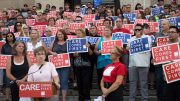Two years after a state of emergency was declared for the COVID-19 pandemic, the government of Manitoba is ushering in a return to normalcy. As recovery plans are being drafted, U of M researchers are asking whether returning to the pre-pandemic “normal” is the best we should ask of our leaders. Sarah Cooper — assistant professor in the department of city planning — and graduate students Lila Asher and Kayla Villebrun-Normand recently published research in a report titled “State of the Inner City: Placing Community at the Heart of the Recovery from COVID” discussing a new normal.
The annual report gathers interviews from community-based organizations (CBOs) and makes suggestions to improve the quality of life of those in the inner city. This year, amid talks of recovery plans, community leaders in Winnipeg’s inner city voiced concerns about how the pandemic had affected people who were already struggling. There was concern government responses would prioritize the middle-class and leave vulnerable people behind.
“Now that governments are beginning to plan for the end of the pandemic, it’s important that the recovery not be about going back to normal, but about building a just city for everyone,” said Cooper.
The inner city is home to a diverse population. Following Winnipeg’s suburbanization after the Second World War, First Nations and Métis people were attracted to the affordable housing and growing communities in the inner city. Similar factors attracted a wave of newcomers and refugees to the area in the 1990s and 2000s. These historical trends have resulted in a concentration of poverty, even racialized poverty, in the inner city.
“We found that the inner city was hit especially hard by the pandemic as a result of pre-existing poverty, precarious housing and homelessness and inadequate access to basic needs,” said Cooper.
The report examined the role of CBOs in meeting basic needs for people in the inner city. CBOs provided crucial support to vulnerable communities in the early days of the pandemic. These organizations often filled in gaps in the social safety net by providing basic services like shelter, food, harm reduction and safety from violence.
These organizations also possess a wealth of knowledge and expertise about the needs of their community. From consultations with CBOs, the authors outlined three priorities for a just recovery: Indigenous self-determination, intersectional equity and social determinants of health.
Self-determination refers to the right of Indigenous peoples to make decisions about their lives and the future of their communities. Many of the underlying causes of poverty and marginalization for people in Winnipeg’s inner city are the result of settler-colonial systems, including housing needs, interaction with the justice system, education and employment opportunities. Recovery plans must include Indigenous self-determination to prevent replicating the harms to Indigenous people.
Intersectional equity is also essential for a just recovery. Intersectionality refers to the ways that an individual’s multiple marginalized identities can build on one another and influence the challenges they face. Intersectional equity would counter those challenges to ensure that all people can live healthy lives regardless of their race, gender, ability or class.
“Addressing the underlying causes of poverty is needed to create a new normal and a more just society,” said Cooper.
Intersectional equity would ensure equal access to the material factors that influence a person’s health beyond access to health care. These include many basics that ensure safety and wellbeing, like quality housing, a healthy diet, community connectedness and safety from violence. These factors aren’t independent — they are interlinked. The authors stressed that the unmet needs of a group of individuals is not a neutral act but rather the result of political choices. To this end, Cooper said governments should “change policies and practices that create and exacerbate poverty and marginalization.”
There are no one-size-fits-all solutions to address inequalities for the diverse communities that live in the inner city. CBOs are therefore necessary to any recovery planning since they best understand the differing challenges and needs of their communities.
“This work must be led by the people and communities that are most affected by it,” said Cooper.
While the federal government initially provided substantial funding through new programs, that funding has ceased, even as the pandemic continues to affect living costs and health risks. Funding from all three levels of government is vital for a just recovery, but distribution of funds should be guided by CBOs.
“Funding alone cannot address the root causes of inequality,” Cooper argued.
Recommendations outlined in the report include investing in communities over physical infrastructure and centring reconciliation in recovery plans.
“Since governments are now beginning to plan for re-opening, it’s a good moment to build on the momentum to advocate for a just recovery,” said Cooper.
At the onset of the pandemic, municipal, provincial and federal governments poured money into social systems and programs. This was evidence to the research team that when there is strong political will, it is possible to fund these programs. They also credit the momentum building in public opinion to address the root causes of inequality. The authors present this recovery as a “once-in-a-generation chance” to strike while the iron’s hot.
“We know that there will be more crises in the future — whether that’s another wave of COVID, another pandemic or an impact of climate change — and the best way to prepare for them is to build resilient communities by addressing inequality and marginalization ahead of time,” Cooper said.
The report’s accompanying video can be viewed at youtube.com/watch?v=CrB1p24-KIk



